Glucose Market Size
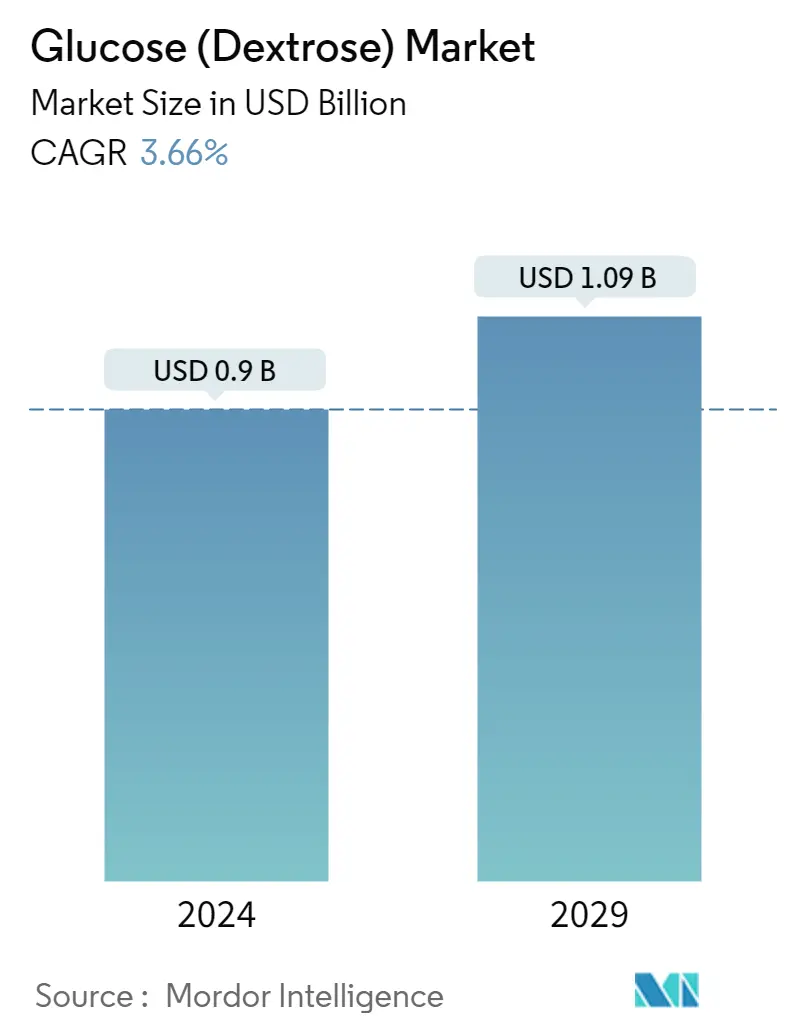
| Study Period | 2019 - 2029 |
| Market Size (2024) | USD 0.90 Billion |
| Market Size (2029) | USD 1.09 Billion |
| CAGR (2024 - 2029) | 3.66 % |
| Fastest Growing Market | Asia Pacific |
| Largest Market | North America |
Major Players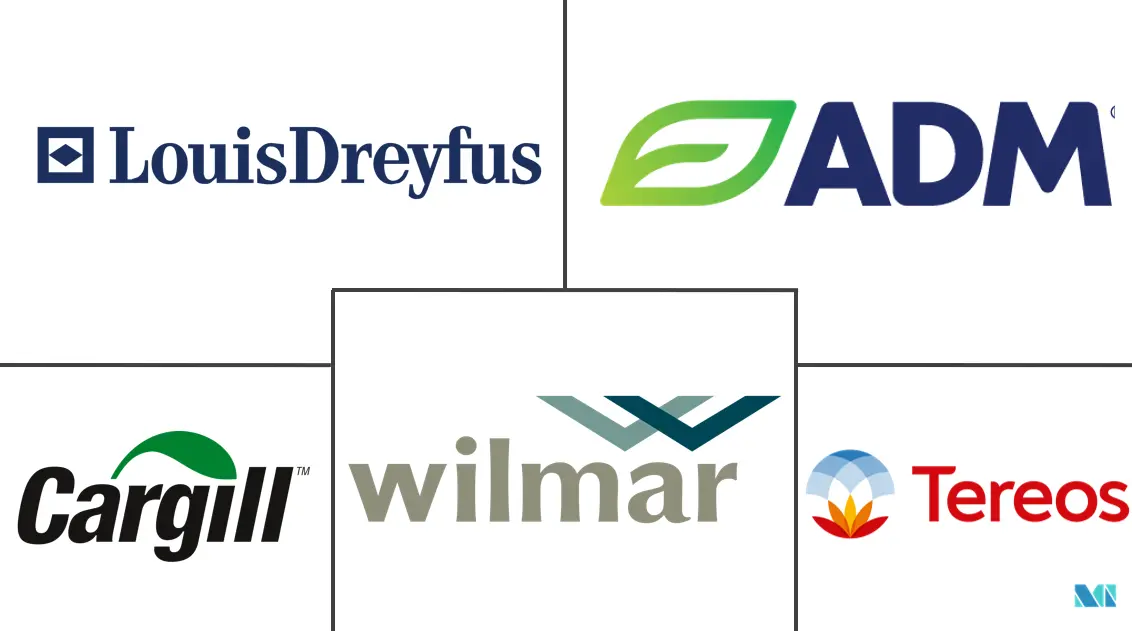
*Disclaimer: Major Players sorted in no particular order |
Glucose Market Analysis
The Glucose Market size is estimated at USD 0.9 billion in 2024, and is expected to reach USD 1.09 billion by 2029, growing at a CAGR of 3.66% during the forecast period (2024-2029).
Dextrose is often used as a sweetener in baking products. It can be commonly found in processed foods like bakery, dairy products, confectionery, etc., as it tastes 60-70% like sucrose. Dextrose is also used in confectionery applications to bring out their (fruity) flavors, provide a light cooling effect, and balance their sweetness. Some of its other application areas include beverages, ice cream, culinary and meat curing, and pharmaceuticals. In milk-based drinks (chocolate or other flavors), dextrose is widely used to control the overall sweetness in combination with other sugars.
Dextrose is very useful in soft-scoopable ice cream, ice lollies, water ices, and other frozen desserts where a clear, moderate sweetness is sought. Dextrose can enhance ice cream's palatability and favorable melt-down properties. The scoopable ice cream at - 18 °C benefits from glucose's ability to lower the freezing point. According to the US Department of Agriculture, in 2021, an average person consumed about 21.9 pounds of frozen dairy across the United States.
Changes in food habits and an inclination toward snacks and desserts, in which dextrose is used as an effective sweetening agent, are driving the use of dextrose in the food and beverage segment. The market is driven by increasing demand for convenience foods with the versatile application of sweeteners with additional health benefits in several industry segments, such as confectionery, bakery, and dairy products. The market faces challenges in terms of fluctuating prices of raw materials, primarily corn, with issues in the supply chain and rapid changes in the global economy. Sugar giants worldwide view wheat and cook starch as sustainable options to produce high-quality glucose syrups that can be used in baked goods, beverages, and ice creams. There has been a growing trend for a clean-label solution, which offers great potential for glucose (dextrose) manufacturers. Companies are upgrading their portfolio with product innovation supported by technological advancements.
Glucose Market Trends
Increasing Application in the Beverage Sector
The beverage industry, including alcoholic and non-alcoholic beverages, is booming with various new players entering the market, thus making the market more competitive. Players are developing innovative products to attract consumers, creating the need for better ingredients, including sweeteners. According to the National Bureau of Statistics of China, a total of 13.8 million metric ton of soft drinks were produced in China in December 2022, representing a 4.6% rise from the same time the year before.
Dextrose can precisely control the sweetness and flavor balance in soft drinks manufactured from concentrated or pulp fruit depending on the particular fruits utilized. Dextrose and high-intensity sweeteners are compatible for usage in different beverages. Additionally, while manufacturing low-calorie beers, the percentage of sugar instantly available for fermentation is increased by quickly adding fermentable dextrose to the wort made from malt and other adjuncts. This produces a low-calorie beer with a regular alcohol concentration. Up to three fermentation stages are used to create specialty beers with higher alcohol content. Inside the bottle, together with extra yeast, the final fermentation occurs. Dextrose is considered ideal as a sweetener in such products because it can be used for fermentation immediately. The versatility and compatibility of glucose with various ingredients are expected to drive the market during the forecast period.
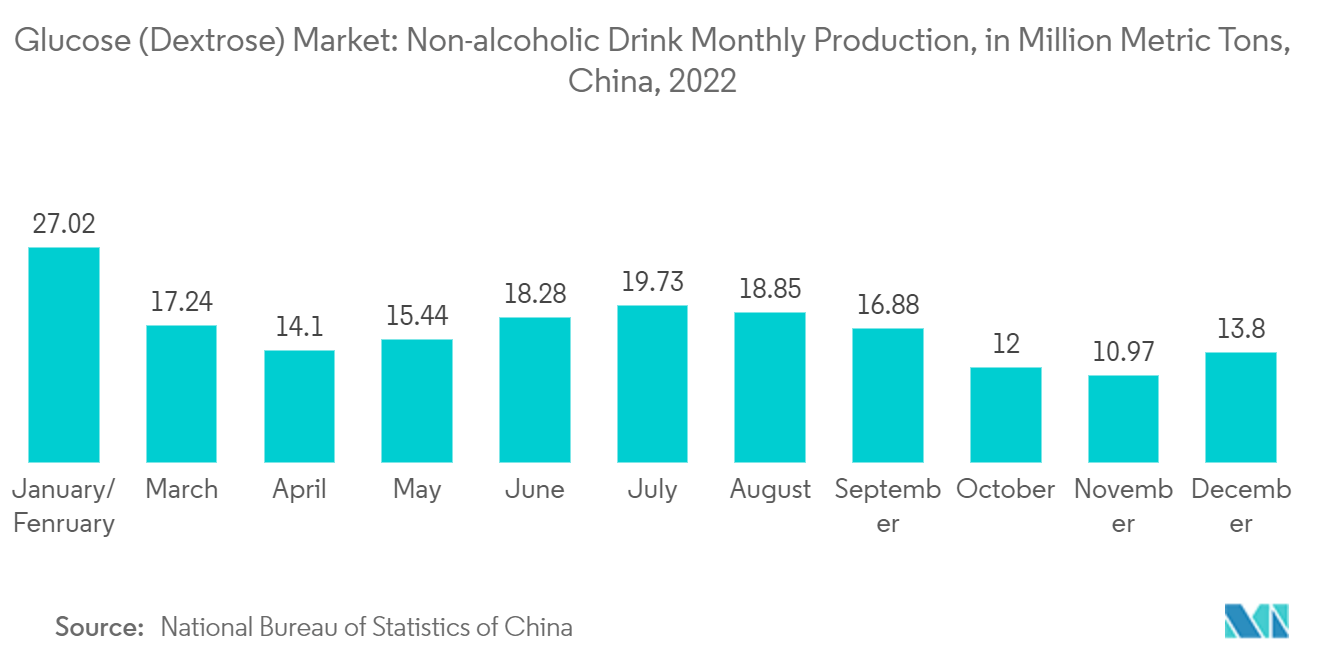
Asia-Pacific is Expected to Emerge as the Fastest-growing Market
The Asia-Pacific region is projected to be the fastest-growing in the dextrose market for food and beverages due to the rising demand for low-caloric food and the large-scale availability and affordability of corn and wheat starch. The region's rapidly growing convenience food and pharmaceutical industries have led to increased consumption of glucose (dextrose) products. In order to maintain a healthy lifestyle, consumers are increasingly looking for energy drinks that contain a significant amount of glucose, thus driving the food and beverage sector, primarily in countries like China, Australia, Japan, and India. The rise in demand for beverages such as energy drinks has been driving the market across the region. Dextrose delivers readily absorbed carbohydrates necessary for sustained energy and endurance in energy and sports beverages.
Dextrose is widely used across the dairy industry. Dextrose enhances shelf life and is suitable for balancing sweetness in dairy and fermented desserts. Ice cream and sorbet's texture and mouthfeel are enhanced by preventing sucrose recrystallization with the addition of dextrose. Dextrose is frequently used in conjunction with other sugars to regulate the overall sweetness in milk drinks (chocolate or other flavors). According to the USDA Foreign Agricultural Service, ice cream and frozen dessert sales in the Indian packaged foods market totaled USD 1.32 billion in 2021. Hence, the thriving dairy industry across the Asia-Pacific region has been propelling the market Aacross the region.
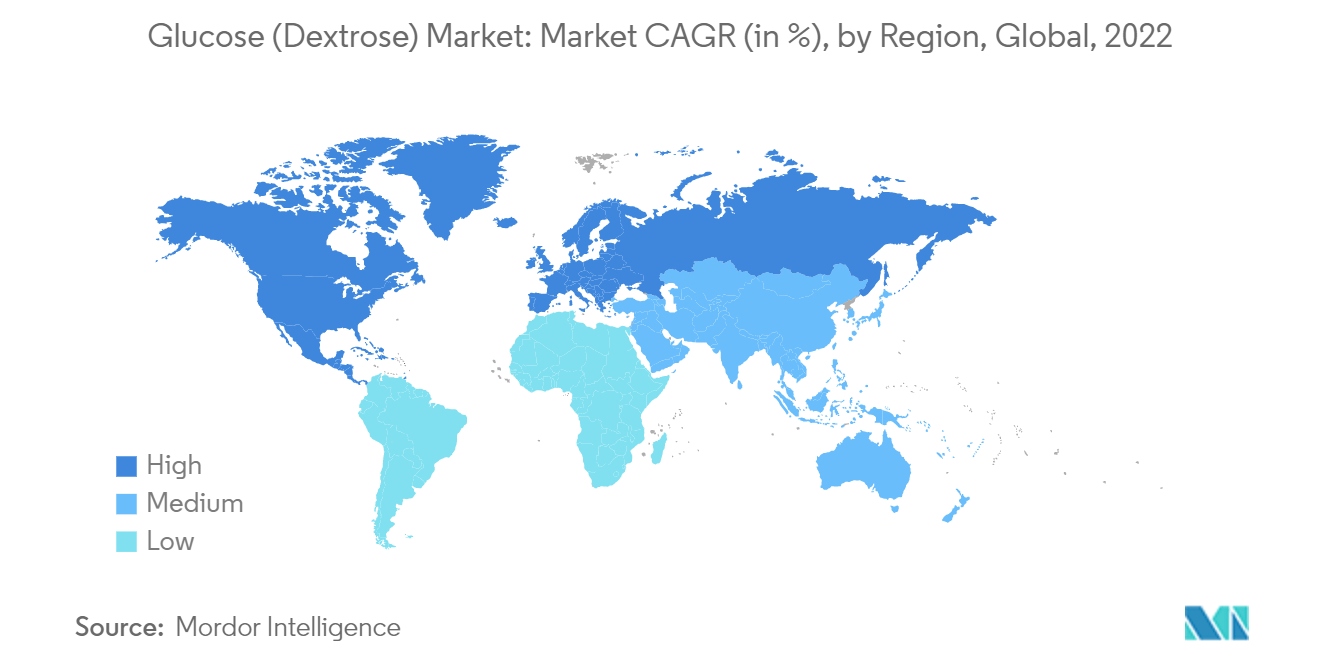
Glucose Industry Overview
The glucose (dextrose) market is highly competitive at the global level. The major players operating in the country, such as Cargill Incorporated, Archer Daniels Midland Company, Tereos SA, Wilmar International Limited, and Louis Dreyfus Holding BV, have strengthened the market through their product offerings. The major global players have vast product lines and geographical reach, which give them an upper hand. In the recent past, continuous product innovations with functional benefits have been the key competitive factor in the market. Key global players have intensified their R&D efforts to develop niche and innovative products based on the end-user industry's requirements. Tate & Lyle, one of the prominent players in the market studied, spent EUR 41 million on research and development in 2021, whereas Tereos SA spent EUR 17.2 million on R&D during 2021-2022.
Glucose Market Leaders
-
The Archer Daniels Midland Company
-
Cargill, Incorporated.
-
Tereos S.A.
-
Wilmar International Limited
-
Louis Dreyfus Holding B.V.
*Disclaimer: Major Players sorted in no particular order
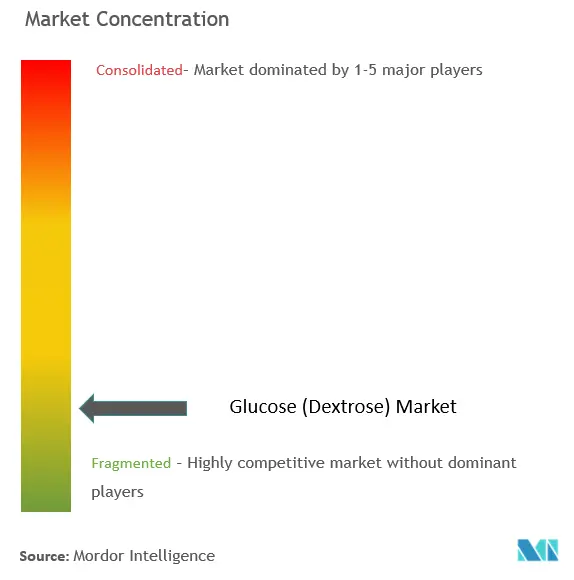
Glucose Market News
- January 2022: Kerry announced the official opening of a new 21,500 sq. ft facility at its Jeddah operation in the Kingdom of Saudi Arabia. Over the past four years, the company invested over EUR 80 million in the region. It was announced that the products manufactured at the new facility would be supplied across the Middle East.
- October 2021: Tate & Lyle PLC (Tate & Lyle), a provider of ingredients and solutions for the food and beverage industry, expanded its partnership with distributor Azelis into three more nations across Europe, i.e., Greece, Bulgaria, and the Republic of North Macedonia.
- February 2021: International Flavors and Fragrances announced the launch of DuPont Nutrition and Biosciences to expand in the market and boost its client base.
Glucose Market Report - Table of Contents
1. INTRODUCTION
- 1.1 Study Assumptions and Market Definition
- 1.2 Scope of the Study
2. RESEARCH METHODOLOGY
3. EXECUTIVE SUMMARY
4. MARKET DYNAMICS
- 4.1 Market Drivers
- 4.2 Market Restraints
-
4.3 Industry Attractiveness - Porter's Five ForceS Analysis
- 4.3.1 Threat of New Entrants
- 4.3.2 Bargaining Power of Buyers/Consumers
- 4.3.3 Bargaining Power of Suppliers
- 4.3.4 Threat of Substitute Products
- 4.3.5 Intensity of Competitive Rivalry
5. MARKET SEGMENTATION
-
5.1 Source
- 5.1.1 Wheat
- 5.1.2 Corn
- 5.1.3 Other Sources
-
5.2 Type
- 5.2.1 Food and Beverage
- 5.2.1.1 Bakery and Confectionery
- 5.2.1.2 Snacks and Cereals
- 5.2.1.3 Beverages
- 5.2.1.4 Dairy Products
- 5.2.2 Pharmaceuticals
- 5.2.3 Other Applications
-
5.3 Geography
- 5.3.1 North America
- 5.3.1.1 United States
- 5.3.1.2 Canada
- 5.3.1.3 Mexico
- 5.3.1.4 Rest of North America
- 5.3.2 Europe
- 5.3.2.1 Spain
- 5.3.2.2 United Kingdom
- 5.3.2.3 Germany
- 5.3.2.4 France
- 5.3.2.5 Italy
- 5.3.2.6 Russia
- 5.3.2.7 Rest of Europe
- 5.3.3 Asia-Pacific
- 5.3.3.1 China
- 5.3.3.2 Japan
- 5.3.3.3 India
- 5.3.3.4 Australia
- 5.3.3.5 Rest of Asia-Pacific
- 5.3.4 South America
- 5.3.4.1 Brazil
- 5.3.4.2 Argentina
- 5.3.4.3 Rest of South America
- 5.3.5 Middle East and Africa
- 5.3.5.1 South Africa
- 5.3.5.2 United Arab Emirates
- 5.3.5.3 Rest of Middle East and Africa
6. COMPETITIVE LANDSCAPE
- 6.1 Most Adopted Strategies
- 6.2 Market Share Analysis
-
6.3 Company Profiles
- 6.3.1 Archer Daniels Midland Company
- 6.3.2 Cargill Incorporated
- 6.3.3 Ingredion Incorporated
- 6.3.4 Roquette Frères
- 6.3.5 Tate & Lyle PLC
- 6.3.6 Tereos SA
- 6.3.7 Südzucker AG (Agrana Group)
- 6.3.8 Louis Dreyfus Holding BV
- 6.3.9 International Flavors and Fragrances
- 6.3.10 Wilmar International Limited
- *List Not Exhaustive
7. MARKET OPPORTUNITIES AND FUTURE TRENDS
** Subject To AvailablityGlucose Industry Segmentation
Glucose (dextrose) is a kind of sugar derived from natural sources like wheat, corn, and other sources.
The glucose (dextrose) market is segmented by source, application, and geography. Based on source, the market is segmented by wheat, corn, and other sources. By application, the market is segmented into food and beverage, pharmaceutical, and other applications. The food and beverage segment of the market is further segmented into bakery and confectionery, snacks and cereals, beverages, and dairy products. The study also covers the global level analysis of the major regions such as North America, Europe, Asia-Pacific, South America, and Middle East and Africa. For each segment, the market sizing and forecasts have been done on the basis of value in (USD million).
| Source | Wheat | |
| Corn | ||
| Other Sources | ||
| Type | Food and Beverage | Bakery and Confectionery |
| Snacks and Cereals | ||
| Beverages | ||
| Dairy Products | ||
| Type | Pharmaceuticals | |
| Other Applications | ||
| Geography | North America | United States |
| Canada | ||
| Mexico | ||
| Rest of North America | ||
| Geography | Europe | Spain |
| United Kingdom | ||
| Germany | ||
| France | ||
| Italy | ||
| Russia | ||
| Rest of Europe | ||
| Geography | Asia-Pacific | China |
| Japan | ||
| India | ||
| Australia | ||
| Rest of Asia-Pacific | ||
| Geography | South America | Brazil |
| Argentina | ||
| Rest of South America | ||
| Geography | Middle East and Africa | South Africa |
| United Arab Emirates | ||
| Rest of Middle East and Africa |
Glucose Market Research FAQs
How big is the Glucose (Dextrose) Market?
The Glucose (Dextrose) Market size is expected to reach USD 0.90 billion in 2024 and grow at a CAGR of 3.66% to reach USD 1.09 billion by 2029.
What is the current Glucose (Dextrose) Market size?
In 2024, the Glucose (Dextrose) Market size is expected to reach USD 0.90 billion.
Who are the key players in Glucose (Dextrose) Market?
The Archer Daniels Midland Company, Cargill, Incorporated., Tereos S.A., Wilmar International Limited and Louis Dreyfus Holding B.V. are the major companies operating in the Glucose (Dextrose) Market.
Which is the fastest growing region in Glucose (Dextrose) Market?
Asia Pacific is estimated to grow at the highest CAGR over the forecast period (2024-2029).
Which region has the biggest share in Glucose (Dextrose) Market?
In 2024, the North America accounts for the largest market share in Glucose (Dextrose) Market.
What years does this Glucose (Dextrose) Market cover, and what was the market size in 2023?
In 2023, the Glucose (Dextrose) Market size was estimated at USD 0.87 billion. The report covers the Glucose (Dextrose) Market historical market size for years: 2019, 2020, 2021, 2022 and 2023. The report also forecasts the Glucose (Dextrose) Market size for years: 2024, 2025, 2026, 2027, 2028 and 2029.
Glucose (Dextrose) Industry Report
Statistics for the 2024 Glucose (Dextrose) market share, size and revenue growth rate, created by Mordor Intelligence™ Industry Reports. Glucose (Dextrose) analysis includes a market forecast outlook to 2029 and historical overview. Get a sample of this industry analysis as a free report PDF download.



